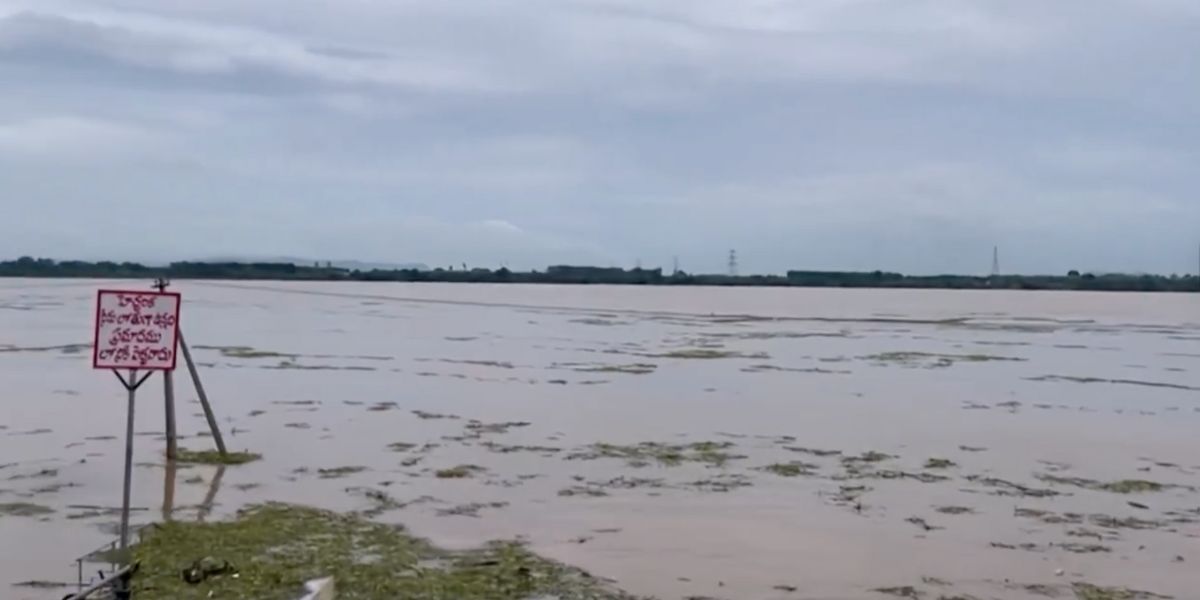The heavy rainfall, triggered by a severe low-pressure system over the Bay of Bengal, has led to massive inflows into the river, with upstream reservoirs like the Taliperu project discharging huge volumes of water into the river.
Published Aug 20, 2025 | 1:01 PM ⚊ Updated Aug 20, 2025 | 1:01 PM

Overflowing Godavari in Bhadrachalam.
Synopsis: Godavari River is rising at Bhadrachalam in Telangana, prompting the officials to issue the first flood warning. Authorities are on high alert as they fear that there could be further increases in water levels, posing a threat of flooding to low-lying areas.
The mighty Godavari River is rising at Bhadrachalam, a historic temple town in Telangana’s Bhadradri-Kothagudem district, prompting the officials to issue the first flood warning.
The increasing inflows are due to relentless rainfall in its upstream catchment areas and from its tributaries. As of 8.15 am on Wednesday, 20 August, the river’s water level at Bhadrachalam was recorded at 43 feet with a discharge of 9.32 lakh cusecs.
Authorities are on high alert as they fear that there could be further increases in water levels, posing a threat of flooding to low-lying areas.
The surge in the Godavari’s water level is attributed to incessant rains across Telangana, Chhattisgarh, and Maharashtra, which have swollen the river’s tributaries, including the Pranahita, Indravathi, and Sabari.
The heavy rainfall, triggered by a severe low-pressure system over the Bay of Bengal, has led to massive inflows into the river, with upstream reservoirs like the Taliperu project discharging huge volumes of water into the river. The rising waters have already submerged the bathing ghats along the Godavari, abutting the floodbank, known as karakatta in local parlance.
Officials have issued warnings to devotees against entering the river for bathing or performing rituals. The Sri Seeta Ramachandra Swamy Temple, a famous pilgrimage site for both Telangana and Andhra, faces a potential threat as floodwaters approach critical levels.
While the temple itself has not yet been inundated, the surrounding areas, including low-lying neighbourhoods, are at grave risk of flooding if the water level crosses the second warning mark of 48 feet.
The town, still reeling from memories of severe floods in 2022 when the river reached 70.50 feet, is bracing for impact. Residents, particularly in areas like Ayyappa Colony, Kotha Colony, and Subashnagar, are anxious, recalling the devastation of past floods when the river reached historic highs of 75.6 feet in 1986.
The district administration has issued alerts to residents in low-lying areas, urging them to remain cautious and prepare for possible evacuation. Road connectivity to nearby mandals such as Kunavaram, Chintoor, and Dummugudem has been disrupted in the past during similar flood events, and officials are monitoring key routes to prevent isolation of the town.
Bhadradri Kothagudem District Collector Jitesh V Patil has initiated flood control measures, including the establishment of a control room at the Integrated District Offices Complex in Kothagudem (contact: 08744-241950) and a WhatsApp emergency line (9392919743).
The National Disaster Response Force (NDRF) and State Disaster Response Force (SDRF) teams are on standby, equipped with boats and expert swimmers to facilitate rescue and relief operations if needed.
Temporary relief camps have been set up in vulnerable areas, and the district administration is closely monitoring the situation, especially with forecasts of heavy to very heavy rainfall in Telangana and neighbouring states over the next 48 hours.
The newly constructed floodbank has so far prevented flooding in Bhadrachalam town and nearby villages. However, locals continue to demand long-term measures, as proposals for further extension of flood banks remain in preliminary stages.
As of Wednesday morning, the Godavari is showing signs of rising further, and the officials expect it to touch the 50 feet mark if inflows persist. As the rain forecast is still valid, the locals fear there might be more inflows into the river, throwing life out of gear.
The authorities are concerned about the impact on tribal habitations along the riverbed, such as Kakisanur, Katukuru, and Velerupadu, which are at risk of inundation.
Residents and devotees have been advised to avoid the riverbanks. With the Godavari continuing to swell, Bhadrachalam remains on edge, hoping that proactive measures and the new flood defences will mitigate the impact of this rising deluge.
The Bhadrachalam flood bank constructed along the banks of the Godavari River is designed to protect the town from flooding. It acts as a barrier to prevent river water from inundating low-lying areas, including residential colonies and the historic Sri Seeta Ramachandra Swamy Temple.
The flood bank was initially built in the 1990s with World Bank aid, following devastating floods in 1986 when the water level of the Godavari reached a record high of 75.6 feet. It was designed to shield Bhadrachalam from recurring floods, which are common during the monsoon season due to heavy rainfall and inflows from upstream tributaries like the Taliperu, Sabari, and Indravati.
The flood bank has been credited with preventing flooding in Bhadrachalam and surrounding villages in recent years. The structure includes sluice gates to manage water flow, though issues like leakages have occasionally caused water to enter the town.
Residents and local organisations have been demanding that the height of the flood bank be raised and that it be extended to areas like Nellipaka and Lakshminagaram to enhance flood protection, particularly due to potential backwater effects from the Polavaram project in Andhra Pradesh.
(Edited by Muhammed Fazil.)
